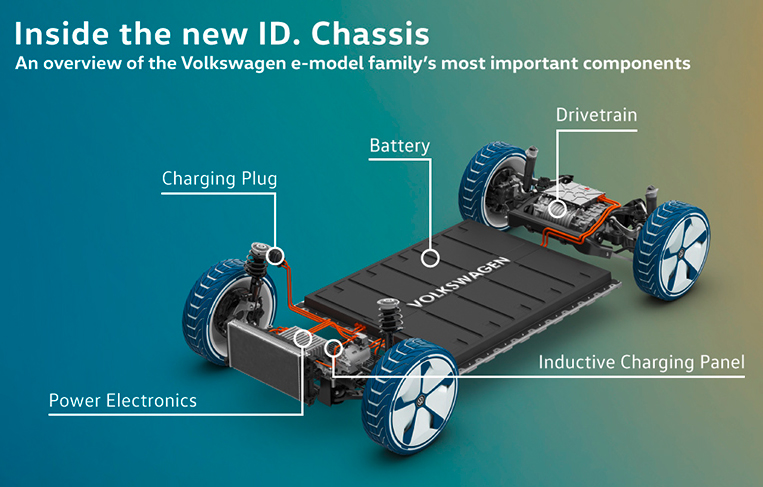
When it first rolled off the production line in 1938, the Volkswagen Beetle gave the average Joe access to affordable and reliable personal transportation. In the following years, the Beetle platform would become the basis for other Volkswagen classic models like the Kombi van and the Thing (Sakbayan). These vehicles were similarly inexpensive and solidly built like the Beetle, and enabled the masses to go out and about in a car they could call their own. In these modern times, Volkswagen wants to approach eco-friendly motoring in the same platform-based manner, and the German automaker is out to do that with its ID. range of electric vehicles.
The Volkswagen ID. family of vehicles isn’t just a regular series of electric cars in the most basic definition of four wheels powered by batteries and electric motors. It’s an entire system of bespoke infrastructure meant not only to support the vehicles themselves but also seamlessly integrate them into their owners’ way of life. This well-rounded approach to electric vehicles means that a Volkswagen ID. car does not put off potential customers with the usual drawbacks of switching to alternative sources of energy.

First, let’s talk about the cars. The ID. vehicles are built off the company’s Modularer Elektrobaukasten (MEB) platform specifically designed for EVs. The MEB chassis makes it the ideal foundation for a range of vehicle types from city cars to SUVs. And because the Volkswagen Group is all about sharing and caring, the MEB can be used by any of the brands under its umbrella. Making cars from a single common base means that economies of scale are achieved and production costs are lowered, therefore making electric vehicles more affordable.
The MEB platform has several clever design and engineering elements that make it the ideal base from which Volkswagen can build reasonably priced electric vehicles. The wheels are fitted as close to all four corners of the car as possible, which lengthens the wheelbase and increases the available cabin space. The drivetrain housed at the rear can be equipped with electric motors of varying power output depending on the application. In front sits the power electronics unit that manages the energy requirements of the electric motor. Finally, the heavy battery pack sits low in the middle, providing a stable foundation for any vehicle type it will be used for.

At the heart of any electric vehicle is its power source—the battery. Volkswagen applies its extensive knowledge from building electric versions of its existing cars in making the ID. batteries. These are still made from lithium-ion, which is the industry standard for current electric and hybrid cars. The difference is in the modular construction of the battery, which offers it unparalleled flexibility for use in the ID. range. For example, the battery pack is like a bar of chocolate. Battery cells can be added or removed depending on the needs of the customers. Either prismatic or pouch-type cells can be used, which gives Volkswagen access to a wider choice of cell suppliers. And speaking of customer needs, users can indeed choose batteries with specific energy ratings depending on how they intend to use their ID. car.
With the demand for electric vehicles continuing to rise each year, the need for supporting infrastructure is now greater than ever. The biggest concern for EV owners is range anxiety, so to that end, Volkswagen is joining forces with Ionity. This is a joint venture with the BMW Group, Daimler AG and Ford Motor Company, the aim of which is to build a pan-European network of fast-charging stations to support the increased use of electric vehicles in the future. The goal is to make 400 “filling stations of the future” operational by 2020. This is on top of the on-site charging stations to be installed at all 4,000 authorized Volkswagen dealers in Europe and a further expansion of the charging network at employee parking lots.

Even the vehicle chargers themselves get a technical makeover. While the ID. can be charged at home via the standard 230V wall socket, Volkswagen knows that owners would want to recharge their vehicles when they get to their destinations. As a result, the company is creating a program that will offer wall box chargers to be installed at office garages and parking lots. ID. vehicles plugged into these power sources will be charged at 22kW compared to the 2.3kW from the home outlet. Publicly accessible quick-charging stations will also be available, and these will offer 125kW of charging capacity. This can fully charge an ID. battery in 30 minutes and will be good for a range of about 550km.
Volkswagen is joining forces with Ionity, whose goal is to make 400 quick-charging stations operational in Europe by 2020
But the chargers don’t just replenish the stored energy within the battery. Volkswagen is working on technology that would enable the cars to supply energy back to the power grid. Vehicles plugged into common-access chargers overnight will serve as extra storage for energy. In case of a sudden drop in the grid’s power supply, the vehicles will act as rolling powerplants, feeding the network with the surplus energy stored in their batteries. For vehicles recharging at home, the Home Energy Management System will help reduce household energy costs by determining the optimal charging cycle based on the customer’s predicted range requirement for the following day. HEMS can also redirect the energy supply to the vehicle’s leftover charge and provide power to the house in case of an outage.
There is a good reason Volkswagen is investing heavily in mobility using alternative sources of energy. It is expected that 150,000 electric vehicles will be sold globally in 2020, and this will only grow as acceptance of such vehicles becomes even more widespread. The Volkswagen ID. series with its cost-efficient approach to e-mobility intends to reach out to potential buyers who would not otherwise acquire an electric car due to the high price. Volkswagen used to be the “people’s car” with the cheap and cheerful Beetle. Now, any one of the brand’s ID. series is poised to be the “people’s electric car.”











Comments